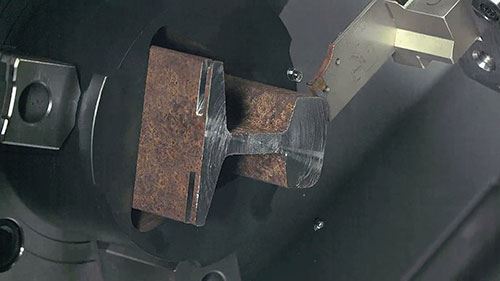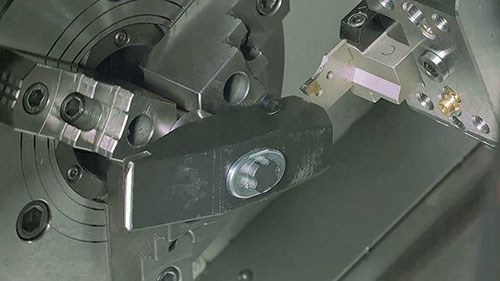Video Highlights Extreme Part-Off Demos
The strength of a tough part-off tool is shown in video showing it parting off a railroad rail and sledgehammer head. Talk about significant interrupted cuts…
Share





Nothing beats seeing video of a wild cutting demo. Iscar provided the footage above that shows an extreme, attention-getting part-off operation it first featured at IMTS 1994 and a second one that’s just as impressive.
In 1976, Iscar released its Self-Grip part-off system and followed that in 1993 with the upgraded Do-Grip system. The company says the Do-Grip featured a proprietary twisted design and was the first to enable a depth of cut deeper than the length of the insert. At IMTS 1994, the company demonstrated how this part-off system could perform under extreme conditions by chucking a railroad rail in a lathe and parting off slices of it throughout the show. The rail material is challenging to cut because it work hardens, the interruption is severe and the workpiece cross-sectional area varies, creating difficult cutting conditions that would cause most tools to fail. The Do-Grip tooling showed little sign of wear or damage.
Iscar revisited this live demo at this year’s IMTS, using its latest Tang-Grip part-off system. The company says Tang-Grip is a single-sided insert with a unique shape and tangentially oriented pocketing technology to further improve insert security and tool rigidity while remaining simple to use. In addition to the rail demo, the video mentioned above shows another challenging part-off demo using a sledgehammer head as the workpiece (this operation is performed at 350 surface feet per minute/0.004 inches per revolution). Like the rail, the sledgehammer head material work hardens and the cut is interrupted. Plus, its hardness varies from 30 to 50 HRc.
Tang-Grip tools are recommended for parting large diameter parts and for interrupted cuts, as the video demonstrates. Their design offers unobstructed chip flow because there is no upper jaw that is common with other clamping systems, which is important for deep grooving and parting applications. The combination of tangential clamping and free chip flow results in improved tool and pocket life, the company says, and provides a solution to the problem of inserts being pulled out during retraction.
Related Content
-
Toolpath Improves Chip Management for Swiss-Type Lathes
This simple change to a Swiss-type turning machine’s toolpath can dramatically improve its ability to manage chips.
-
Sandvik Coromant Turning Tools Enable Y-Axis Turning
The company has developed two new tools to support Y-axis turning: CoroTurn Prime and the CoroPlex YT twin-tool.
-
Norton | Saint Gobain Abrasives' Wheels Increase Metal Removal
The Norton Winter Paradigm Plus Diamond and Winter G-Force Plus Next Generation Diamond Wheels expand the company’s grinding wheel options.


















.png;maxWidth=300;quality=90)




